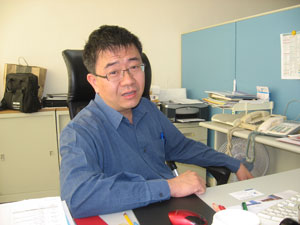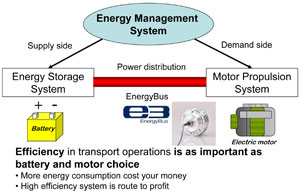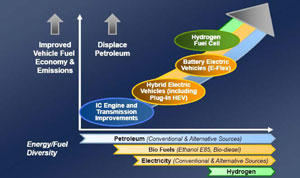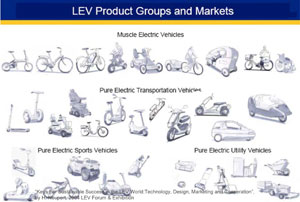EnergyBus Promises to Improve Compatibility of LEV E-components
2009/04/20 | By Quincy LiangElectric vehicles have become one of the main focuses of the global effort to conserve energy and protect the environment. At the present time, most development is aimed at designing personal vehicles for short-distance mobility and public transport vehicles for medium- and long-distance transportation.
Taiwan, with its strong technological and manufacturing capabilities, is an ideal location for the development and production of light electric vehicles that are strongly competitive in terms of technology and cost.
The EnergyBus, a new standard for connecting the electrical components of light vehicles, promises to improve the compatibility of electric components in light electric vehicles (LEVs). It utilizes a standardized set of plugs and a communication (bus) protocol that is based on CAN-bus and further specialized to meet the specific needs of the LEV industry. The initial goal of this revolutionary concept is to connect batteries and chargers, and later on to extend the standard to other components such as motors, controllers, and user interface.

Behind-the-Scenes Booster
The EnergyBus will eliminate the inconvenience caused for users worldwide by incompatible power voltages, plug standards, recharging infrastructures, etc. These problems are some of the biggest obstacles to the popularization of LEVs, and their elimination will lead to much greater product availability in the market.
The benefits of the EnergyBus standard may begin to emerge within a year, thanks largely to its behind-the-scenes developer and booster, Dr. Yang Mo-hua. Dr. Yang is the chief technology officer (CTO) of HiTech Energy Inc., a major Taiwanese battery-management system (BMS) solution provider. He is also president of EnergyBus e.V., a non-profit association that was founded in Taiwan in early 2007 (and is now based in Germany) to provide a platform where institutions and industry representatives can work together on the development and marketing of EnergyBus.
"I have been working on the EnergyBus for over 10 years, ever since I came back to Taiwan after completing my advanced study and went to work for the Material & Chemical Research Laboratories (MCRL) of the Industrial Technology Research Institute (ITRI) in 1997," Yang recalls. "I recognized that Taiwan was the best place to manufacture light vehicles of the best quality, including electric models, because most the latest ideas from all over the world can be commercialized by Taiwanese makers."
"However, I thought that local players should play an even more important role in the global division-of-labor scheme by focusing not on manufacturing alone but also on upstream innovation. The EnergyBus is my guideline for the local LEV industry, through which creative and innovative makers on the island can pursue their products positively and independently."
Yang points out that the biggest opportunities for Taiwan manufacturers likely lie in system integration--the energy management system that connects the energy storage system and the motor propulsion system. "Only after a common standard emerges in Taiwan will local LEV makers be able to make inroads," Yang says, "because, generally speaking, most vehicle makers on the island do not know much about energy management, and neither do our battery makers."

Key Factors in LEV Development
There are three key factors in the successful development of LEVs, Yang stresses: communication interface, safety standard, and energy-supply service system (business model) for the energy (battery) system.
The first factor is what EnergyBus is addressing now; while BATSO (the Battery Safety Standards and Certification Organization), a cooperative project between ExtraEnergy, ITRI, and the testing organizations TUV Rheinland Taiwan and UL Taiwan, is working on the second.
"Taiwan is internationally known for its battery and motor industries, but it lacks expertise in energy management systems," Yang comments. "Efficiency in transport operations is as important as battery and motor choice. Simply speaking, you will not be able to produce the world's best LEV if you have only the world's best battery and motor. So the EntergyBus standard will be a key force in advancing the local LEV industry from merely producing components and assembling them to working out total LEV solutions and high-level complete vehicles."
EnergyBus aims to improve the compatibility and safety of LEVs through the development of connectors and communication protocols. The EnergyBus standard consists of a standardized set of connectors which safely link LEV electric components such as batteries, chargers, motors, sensors, and human interfaces. These components communicate with each other via a CAN-based protocol. The uniform exchange of information enables the components to operate at maximum performance.
"The EnergyBus is crucial to both users and makers of LEVs," claims Yang. "We are trying to map out an intelligent data/power/communication protocol for the LEV industry, similar to the universal serial bus (USB) standard for the personal computer (PC). With such a standard, manufacturers will be able to make what they want and do it without the constraints of communication incompatibilities between different systems."

Goals
The EnergyBus standard has several goals, Yang explains. First, it aims to resolve many of the problems that the LEV industry is facing as it grows, especially compatibility and safety issues. Second, it is designed to make components more compatible so as to achieve faster and more efficient product development and expand the range of product choices for high-quality vehicles on the market. Third, EnergyBus aims to be the basis for designing public LEV infrastructure such as rental stations and the swapping of machines without any single manufacturer having a monopoly. Fourth, it aims to pave the way for LEVs to enter the mass market.
"The CAN-bus has revolutionized the car industry, the USB standard has revolutionized the computer industry, and Bluetooth has revolutionized the cellphone industry," Yang says. "EnergyBus will do the same for LEVs."
According to Yang, the EnergyBus has attracted big international players in the vehicle and parts industries to participate in joint discussions and standard-setting, but many companies-including some in Taiwan--are still holding to a wait-and-see attitude. "The EnergyBus standard is expected to succeed first in the international stage rather than in Taiwan, though that was not my original intention," Yang comments. "But we still hope that local companies will pay more attention to it because Taiwan has very strong manufacturing advantage in the information and communication technology (ICT) line, though not at all in the complete-car business. The only chance left for Taiwanese companies in the global transportation market should be LEVs, including electric bicycles, tricycles, mini-cars, and other types of multi-wheel vehicles with power propulsion systems using under-60V electricity (the higher-voltage market will be pursued by a large group of strong international auto and other manufacturers)."
Yang happily announces that the first-phase EnergyBus standard has been mapped out and a trial-edition of the product is expected to be introduced this year. The first formal-edition EnergyBus for global vehicle makers and consumers will be released in 2010 or 2011, Yang says. The 10-year period of development is similar to the time it took to develop the USB standard.
"There will be many other possibilities for the EmergyBus than the LEV industry alone," Yang says confidently. "With the common communication protocol, for example, I think in the near future there might be some 'free LEVs,' like 'free handsets,' that will present opportunities for companies to make money by providing services instead of selling vehicles. And maybe, also in the near future, the LEV market will no longer be led or determined by vehicle makers, but by the strategic policies of city governments in choosing their infrastructures--like some cities, for instance, plan to further strengthen public transportation and personal mobility so as to prevent cars from entering the cities."


